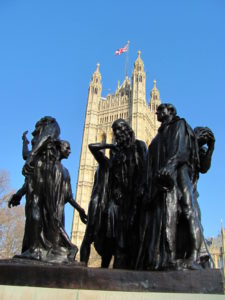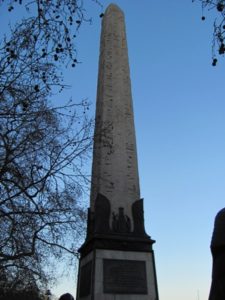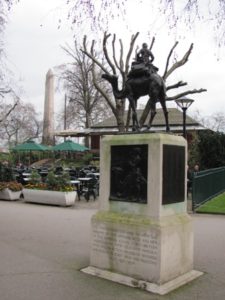This is just the way I am: Every time I travel in a foreign city I try to find Jerusalem in it. Rabi Nachman of Breslau once said that wherever he goes he always goes to the land of Israel. My traveling companions already know the every tour even to the furthest city is basically a tour in Jerusalem with small modifications of scenery and atmosphere.
Lately I took a short vacation in London with my wife Noa. Just make sure you understand that my vacations include about 10km of walking and one museum a day. Well, this is just the way I am. I wanted to be ready and prepared myself at home. I wanted to visit some London sites that left an impression on Jerusalem. I planned on visiting the grave of General Allenby, the man who conquered Jerusalem during World War I and lies today in Westminster abbey. I also remembered Sennacherib’s relief depicting the conquest of Lachish. The relief is displayed at the British museum and copies of it can be found at the Israel museum in Jerusalem and in the Institute of Archeology in the Hebrew university of Jerusalem. I even planned on visiting the Churchill war room. Churchill was the leader who “tore” the eastern bank of river Jordan from its western bank in his white paper from 1922. Reading my well prepared list I thought it was an impressive amount of Jerusalem sites in one city. As I discovered later I was not a bit prepared at that point for the real number of times I was going to remember Jerusalem during my time in London.
My first encounter was while walking on a lawn along the River Themes near the parliament building. Just around the corner I spotted a familiar figure. The black shiny figure was standing among a few other similar figures. One look at the statue took me back to Jerusalem. It was the statue known as “Les Bourgeois de Calais” by the famous Auguste Rodin. The statue depicts the surrender of the citizens of Calais to Edward III during the Hundred Years’ war. Till today, the Original statue is situated in the city of Calais and 12 replicas are spread across the world. As you can see, one can be found in Westminster, London and another in the Israel museum in Jerusalem.
As we continued our tour of London we visited the Big-Ben and watched the changing of the guard at the Buckingham palace, strolled in the St. James gardens and even found the statue of queen Boudica, the queen who burnt London to the ground. Then we encountered Jerusalem again. We were sitting in a place called Embankment not far away from a meander of the Themes. There, in the heart of a small garden we found a modest memorial. Examining it closely told us it was a memorial for the British soldiers, most of whom were Australians and New-Zealand citizens that served in the Imperial camel corps in Sinai. These people conquered Jerusalem and their dead are buried till today in the Commonwealth war graves cemetery situated on Mount Scopus in Jerusalem.
By the way, not far away from this memorial, on the bank of the river Themes you can find Cleopatra’s Needle, an obelisk given to Queen Victoria by Mohamed Ali, another famous conqueror of Jerusalem. The obelisk is more ancient then Cleopatra and is dated to the time of a Pharaoh known as Thutmose III. The same pharaoh that conquered the land of Israel in the 15th century BC and thus brought a new era to the land: the late bronze period.
Our London tour was not over yet and I was haunted by Jerusalem. In Victoria and Albert museum we encountered a familiar glass exhibit. A similar one can be found in the Tower of David museum in Jerusalem and there is no wonder: The artist was no other than Dale Chihuly whose works were exhibited in Jerusalem during 1998-2000. The exhibition is considered the most successful exhibition of all times in Israel. Over a million people visited it. In Kensington gardens we passed a few gigantic statues. It was a temporary open exhibition of works by the artist Anish Kapoor. Born in India, Anish Kapoor graduated from the Bezalel academy of arts and design in Jerusalem and his work “Turning the world upside down” is standing in the Israel museum today.
We found quite a few signs in the city advertising for “Krav Maga” courses. We know those signs from the streets of Jerusalem. Feeling a bit haunted again we decided to take refuge in the nearest museum – The Tate Britain. The museum specializes in painting of the great British artists of the 18th and 19th centuries. There we thought there was no danger of finding Jerusalem again. Alas, I was disappointed again when among the wonderful works of William Turner I found Jerusalem once more. From a small painting a familiar tombstone peered at me. It was Absaloms tomb of the Kidron Valley just beneath the Mount of Olives. It was a bit of a surprise when remembering that Turner, although traveling a lot never got to Jerusalem. Not far away from this picture I found another friend from Jerusalem. A few works by the artist Holman Hunt, who lived in the Nevi’im st. in Jerusalem, were on display. This is how I learnt that Hunt is considered one of the most influential artists in 19th century British art. I will remember him during my coming tours in Jerusalem while I will be sitting on bench built and dedicated to Hunt by his wife. A bench which still sits near Mar Elias monastery on the Hebron road in Jerusalem and shows a spectacular view of the Judean desert.
I could bring a hundred more examples proving that London and Jerusalem are twin cities with a strong and deep connection. I even thought about starting a Facebook group supporting the formalization of the connection. I had many more ideas but I suddenly realized that the connection to London can’t be unique. There must be so many other cities in the world having a similar affinity to Jerusalem – Cairo, Paris, New-York and many others. To make a long story short – doesn’t matter where I go, I can always find a snippet of Jerusalem there.


